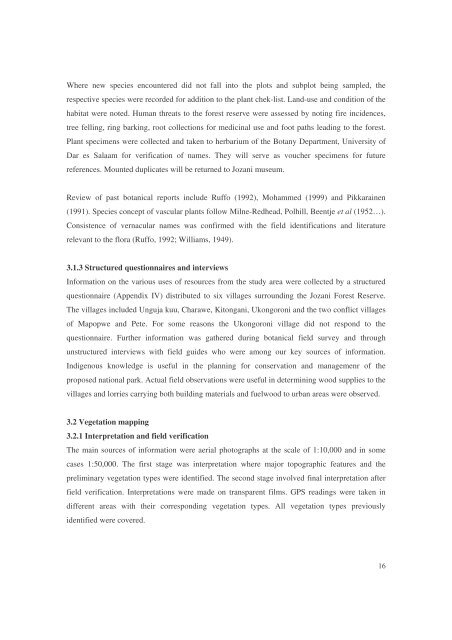Jozani biodiversity inventory report 2002 - Coastal Forests of Kenya ...
Jozani biodiversity inventory report 2002 - Coastal Forests of Kenya ...
Jozani biodiversity inventory report 2002 - Coastal Forests of Kenya ...
Create successful ePaper yourself
Turn your PDF publications into a flip-book with our unique Google optimized e-Paper software.
Where new species encountered did not fall into the plots and subplot being sampled, the<br />
respective species were recorded for addition to the plant chek-list. Land-use and condition <strong>of</strong> the<br />
habitat were noted. Human threats to the forest reserve were assessed by noting fire incidences,<br />
tree felling, ring barking, root collections for medicinal use and foot paths leading to the forest.<br />
Plant specimens were collected and taken to herbarium <strong>of</strong> the Botany Department, University <strong>of</strong><br />
Dar es Salaam for verification <strong>of</strong> names. They will serve as voucher specimens for future<br />
references. Mounted duplicates will be returned to <strong>Jozani</strong> museum.<br />
Review <strong>of</strong> past botanical <strong>report</strong>s include Ruffo (1992), Mohammed (1999) and Pikkarainen<br />
(1991). Species concept <strong>of</strong> vascular plants follow Milne-Redhead, Polhill, Beentje et al (1952…).<br />
Consistence <strong>of</strong> vernacular names was confirmed with the field identifications and literature<br />
relevant to the flora (Ruffo, 1992; Williams, 1949).<br />
3.1.3 Structured questionnaires and interviews<br />
Information on the various uses <strong>of</strong> resources from the study area were collected by a structured<br />
questionnaire (Appendix IV) distributed to six villages surrounding the <strong>Jozani</strong> Forest Reserve.<br />
The villages included Unguja kuu, Charawe, Kitongani, Ukongoroni and the two conflict villages<br />
<strong>of</strong> Mapopwe and Pete. For some reasons the Ukongoroni village did not respond to the<br />
questionnaire. Further information was gathered during botanical field survey and through<br />
unstructured interviews with field guides who were among our key sources <strong>of</strong> information.<br />
Indigenous knowledge is useful in the planning for conservation and managemenr <strong>of</strong> the<br />
proposed national park. Actual field observations were useful in determining wood supplies to the<br />
villages and lorries carrying both building materials and fuelwood to urban areas were observed.<br />
3.2 Vegetation mapping<br />
3.2.1 Interpretation and field verification<br />
The main sources <strong>of</strong> information were aerial photographs at the scale <strong>of</strong> 1:10,000 and in some<br />
cases 1:50,000. The first stage was interpretation where major topographic features and the<br />
preliminary vegetation types were identified. The second stage involved final interpretation after<br />
field verification. Interpretations were made on transparent films. GPS readings were taken in<br />
different areas with their corresponding vegetation types. All vegetation types previously<br />
identified were covered.<br />
16
















